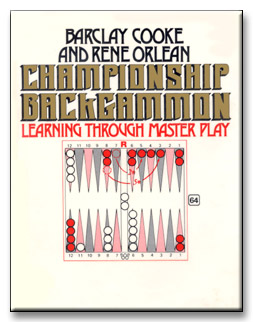| |

|
Championship Backgammon
Barclay Cooke and Rene Orlean
1980, 338pp, Prentice Hall
ISBN:0131261029
|
Barclay Cooke was one of the legendary players on the International tournament circuit during the 1960's and 1970's. Since the halcion days of the 70's backgammon boom, Cooke's game plans and tactics have engendered much criticism particularly since advent of the modern neural net backgammon programs. (See for example, Jeremy Bagai's excellent critique of 70's play, Classic Backgammon Revisited, which highlights numerous conceptual blunders in Paradoxes and Probabilities with the aid of Snowie.).
Championship Backgammon marks the final chapter in Cooke's "trilogy" of backgammon works (see also reviews of The Cruelest Game, and Paradoxes and Probabilities), and does little to break the mould set by its predecessors. In short, the text bears shocking testament to the relatively low standards of the 70's game. In comparison to todays top players, Cooke and his ilk would be classed as Advanced/Intermediate players.
The modern student of the game would gain little technical knowledge from the text. However, the book is worthy of perusal for a number of other reasons, not least of which are its historical and entertainment value. In Championship Backgammon, Cooke teamed up with Canadian Champion Rene Orlean, providing lively, and at times brutal, commentary on the first 16 games of an Inter-Atlantic Duplicate Backgammon challenge between the USA and Great Britain. The tournament, played at London's Clermont club, pitched Barclay Cooke and his son Walter (Team USA) against British backgammon stars Joe Dwek and Phillip Martyn, in a series of 40 'money-games'. The novel format of Duplicate Backgammon was an attempt to minimize the luck element of the game.
"Two tables were to be set up in different rooms, each pairing one Englishman against one American. If at Table 1, England had the Red men, then at Table 2, America would be Red. A referee would roll the same dice for both tables, so that, throughout the match, every roll would be the same for both teams, and, theoretically at least, no complaints [about luck] by either side would hold water, because whatever number any contestant would be required to play, the other member of the opposing team had to do likewise in the other room."
The first three concise sections of the book relate the historical background to the match and feature entertaining mini-biographies of the players. These introductory sections reveal key differences in the style and attitude of the protagonists and amply set the scene and suspense for the meat of the book — the sharp critical play-by-play commentary from the two authors.
Numerous tri-color board diagrams illustrate each key position, however modern readers may take some time to get used to the arcane board notation (R5, W5 etc) and the use of arrows indicating the actual move played may spoil the enjoyment of those readers who prefer a 'match-quiz' format. Cookes technical analyses, though often way off the mark, are as ever, an entertaining window on the thought processes of the 'experts'. A keen focus on the psychological state of the players during each game does much to amplify the book's overall resonance.
In summary the book would only be of interest to the keenest modern enthusiast or collector. Beginners would likely find the style far too advanced and Intermediate/Advanced would find much to criticize from a technical viewpoint.



![]()
